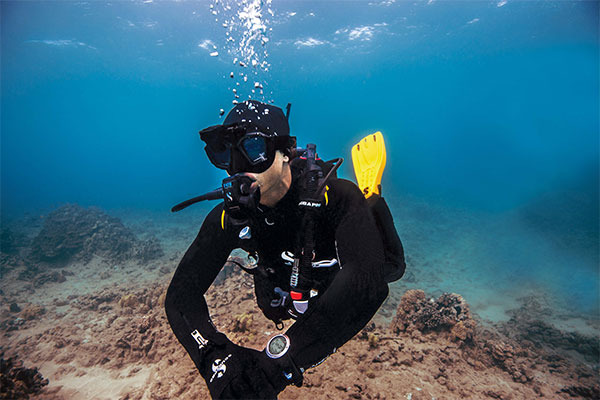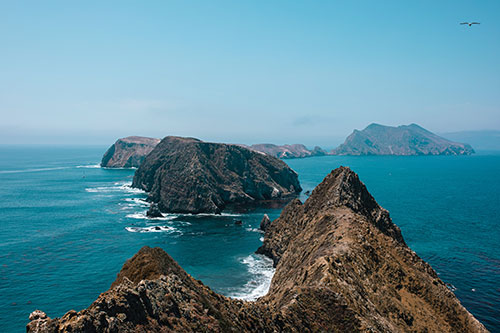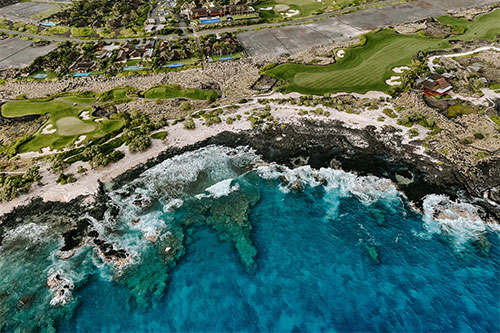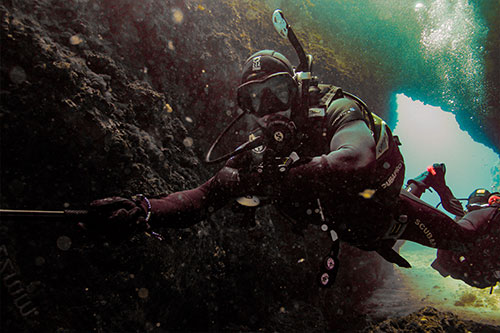Best Autumn Diving in the U.S.
Autumn brings change of seasons and the end of many vacations, but that doesn’t mean you need to pack away your dive gear. In many destinations, fall provides the best dive conditions of the year.
Let’s explore some of the best autumn diving in the United States.

California Oil Rigs
Long Beach, California
Imagine taking a giant stride into the ocean and seeing the horizontal, vertical and diagonal structure of an oil rig descend through blue water into the depths. Sea lions zoom around, occasionally bursting through clouds of fish slowly navigating this mid-water reef. Upon closer inspection of the structure, you notice that every inch is covered in marine life. There are colorful cup corals, scallops, and scorpionfish all clinging to this bastion in the open ocean.
There’s no doubt that a dive on one of California’s oil rigs is a unique experience. Conditions vary widely but fall generally brings the warmest water and best visibility. This dive has no (recreational) bottom, so advanced certification and excellent buoyancy control are required.
Anacapa Island
Channel Islands National Park, California
Explore the kelp forests of Anacapa Island from one of several dive boats that make single day and overnight trips to the Channel Islands. Anacapa is the most accessible island after Catalina, and boasts healthy reefs with abundant marine life. Divers can experience sunlight dancing through the kelp canopy while looking for sea lions, harbor seals, and bat rays, or take in the macro life with a range of nudibranchs, small fish, and more. California dive boats are known for tasty lunches and surface snacks, so you’ll be well-fed throughout your journey.

Blue Heron Bridge
West Palm Beach, Florida
Small critter lovers will rejoice in diving the iconic Blue Heron Bridge, which is considered one of the hottest sites for macro photography in the U.S. The area is home to a wide array of benthic marine life, including exotic species that are rare to see in other places. Successfully finding these cryptic camouflaged animals is another challenge in itself!
Phil Foster Park provides parking, easy access to the site, and facilities. Blue Heron Bridge should only be dived at high slack tide. Maximum depth tops out at just 20ft (6m).
USS Spiegel Grove
Key Largo, Florida
Arguably one of the most iconic U.S. shipwrecks, the USS Spiegel Grove is a highlight of any dive trip to Key Largo. This decommissioned Navy ship is almost two football fields in length, offering divers a very large artificial reef to explore over several dives. The diving is done on day boats, which also gives divers access to all the rich diving in Key Largo, including other wrecks, reefs and the famed “Christ of the Abyss” statue. As with all destinations, be sure to monitor the weather prior to your trip, as autumn is the tail end of hurricane season.
Pelagic Magic
Kona, Hawaii
Thrill seekers and critter lovers will enjoy blackwater diving off the coast of Kona. These dive trips, titled Pelagic Magic, take divers out for open water night dives searching for rare pelagic marine life and juvenile drifters. Divers tether to a buoy suspending a lighted line over the black abyss to see what animals rise to the surface, then enjoy the show from a depth of about 50ft (15m) or shallower.
Common subjects include jellyfish and zooplankton that migrate towards the surface every night to feed, but the real highlights will be unique juvenile fish and cephalopods that haven’t yet settled on a home reef. The Pelagic Magic dive is so popular with photographers that similar night dives have popped up around the world.

Clear Lake
Oregon
Clear lake is exactly that; it’s exceptionally clear with over 100ft (30m) visibility, reaching up to 200ft during the fall. This makes it a regular visit for Oregon divers who would otherwise face very low visibility on the coast. The lake is closed to motorized boat traffic and has features like a sunken forest, dazzling light displays in the shallows, and deep potholes for divers to check out. The lake is cold, however, so be sure to bring the proper wetsuit or even a drysuit.
Bonne Terre Mine
Bonne Terre, Missouri
Take a journey below the surface and into the history of a massive lead mine. The Bonne Terre Mine is set up for scuba diving with daily tours taking divers along 50 planned routes. These routes are lit with stadium lighting, allowing divers to focus on the many artifacts left behind when the mine closed. While diving inside a mine may not be for everyone, only an open water certification is required to book a package. All dives are led by a guide and include an extra safety diver. Boat and walking tours are available for non-divers as well.

Dutch Springs
Bethlehem, Pennsylvania
Dutch Springs attracts divers from Pennsylvania and beyond. The 50-acre lake has nice visibility and features many different vehicles and structures in depths up to 100ft (30m), including large trucks, planes, a trolly and much more, making it a playground for experienced divers and dive classes alike. The lake is also home to several species of fish. The lake temperature drops during the fall, so be sure to book your trip earlier if you’d like the warmest water. The park charges an admission fee and offers various guided dive experiences.
Puget Sound
Greater Seattle Area, Washington
The unique diving of the Puget Sound forms the base of a vibrant dive community. Dive sites stretch up and down the coast with a number of points, sand slopes and artificial reefs packed with classic Pacific Northwest marine life. This is the place to come if you’d like to see a Giant Pacific Octopus, a Wolf Eel or a cute Pacific Spiny Lumpsucker. Dive sites have fairly easy access and should be planned for slack tide in order to avoid the strong currents that form as water is pushed through the Sound. Most avid divers in the area opt for drysuits when diving in autumn.






